Study on the Relationship between Chlorite Clay Film Diagenesis and Sedimentary Facies in Reservoir Sandstones
Abstract
A large amount of oil and gas has been found in Chang 6 Formation sandstones in Huaqing region of Ordos Basin. It is controversial whether the chlorite clay film is one of the main controlling factors of high quality sandstone reservoirs in this area. On the basis of previous studies, the chlorite clay film in sandstone reservoirs in the working area was studied by X-ray diffraction, casting thin section, scanning electron microscope, energy spectrum, and other analytical methods. The results show that the sandstones developed by chlorite clay films are closely related to the strong hydrodynamic deposition condition. The formation of chlorite clay film is a gradual process, and the particle coating is mainly formed in the early stage. The material source is the Fe-bearing flocculation precipitation produced when the river enters the lake. The chlorite lining is mainly formed in the later stage, and its material source is mainly iron ions produced by the dissolution of clastic particles such as feldspar or rock debris. The chlorite clay film cannot prevent the cementation and cannot protect the intergranular pores. Therefore, the better physical properties of the sandstones with the chlorite clay film in the Chang 6 Formation of the Huaqing region are related to the petrological characteristics of the sandstone deposited under strong hydrodynamic conditions and have little relation with chlorite clay film.
1. Introduction
The authigenic chlorite is a common clay mineral in cements of the reservoir sandstone and widely distributed in sandstone reservoirs. The chlorite clay film is often formed on the grain surface of the sandstone. Due to the good physical properties of the sandstone reservoir cemented with chlorites, the preservation mechanism of the chlorite clay film in the sandstone to the pores has been a research hotspot. There are many researches focused on the relationship between the chlorite clay film and physical properties. Pittman [1], Ehrenberg [2], Billiault et al. [3], Bloch et al. [4], Huang et al. [5], and Yiqun and Wenhou [6] all believe that the chlorite clay film can inhibit the growth of secondary quartz, which is the main mechanism of the pore preservation in sandstone reservoirs buried deep. Other scholars, such as Guangfa and Sheqin [7], Lin yu et al. [8], Jian-feng et al. [9], and Xiang et al. [10], believe that authigenic chlorite cannot protect intergranular pores. Hou, Liang, and Jin. have studied the chlorite clay film [11–20].
Little researches have been done on the relationship between chlorite clay films and sedimentary facies. Baker et al. [21] and Jinku et al. [22] found that there was a certain correlation between chlorite clay films and sedimentary facies, but they did not study the relationship between the chlorite clay film, sedimentary facies, and physical properties in detail.
This paper takes the reservoir sandstone in the Huaqing region in the central Ordos Basin as the research object. Starting from the relationship among its chlorite clay film, sedimentary facies, and physical properties, the formation process of chlorite clay film and its control of physical properties are studied. It has a positive significance for oil and gas exploration in the Huaqing region.
2. Geological Setting
The Ordos Basin can be divided into six first-order tectonic belts: the western margin thrust belt, the Jinxi circumferential fold belt, the Yimeng Uplift, the Tianhuan Depression, the northern Weibei uplift belt, and the Yinshan slope belt. The study area is located in the southwest of the center of Yinshan Slope of the Ordos Basin (Figure 1) [23]. The structure is relatively simple, and the slope of the west-dipped monoclinal structure is generally less than 1°.

The Yanchang Group of the Upper Triassic is a set of terrigenous clastic rock sediments with a thickness of 1000~1300 m, which is set in a large sag basin, dominated by river and delta facies at the basin margin and dominated by the lake facies in the basin [24]. The Yanchang Group can be divided into 10 formations (Chang 1 ~ Chang 10 Formation), as is shown in Figure 2. The sedimentary period of the Chang7 Formation is the peak period of lake basin development and the most developed period of hydrocarbon source rocks in the Yanchang Group. The Chang 6 Formation is a combination of sandstone and mudstone interbed in cyclic rhythm, 120~150 m thick, which can be subdivided into three layers of Chang 63, Chang 62, and Chang 61 from the bottom to the top, and integrated contact with the underlying Chang 7 Formation [25].

The regional lithofacies paleogeographic pattern is affected by the uplift and return of the basement and the strong sedimentation and filling of peripheral clastic materials after the Chang 7 maximum lake transgressive period, and the ancient land of Yinshan is the main source direction due to the north [22].
In the north of Huaqing region, there is the delta skirt of Wuqi-Jingbian-Ansai which extends from the north to the south toward the lake. The deposition system of slump turbidity current under the background of semideep lake and deep lake in the Huachi-Qingyang region is formed in the delta front due to the gravity collapse of the sedimentary body because of its instability [26].
3. Sampling and Analysis Methods
Datum for this study was mainly from 150 core samples from 15 drilling wells in the Huaqing region of the Ordos Basin. The sample was impregnated with a red epoxy resin for wafer fabrication, and the red color is the porosity when it is viewed under a Zeiss optical microscope. Each sample is counted several times for the statistics of the particle size, sorting, composition, and face rate. Field research institute and the microscopic identification were analyzed by Lanzhou geological institute. Twenty lithological samples were made into diameter plugs, and mercury injection curves were tested. The surface layer of the 20 samples was studied through using a scanning electron microscope equipped with an energy dispersive X-ray spectrometer. The 20 rock samples were also tested for porosity and permeability in Helium. The whole rock of the 30 samples was grounded into powder for X-ray diffraction (XRD) test and analysis. Scanning electron microscope (SEM) analysis was performed in Lanzhou Institute of Chemical Physics.
The helium porosity, permeability, and mercury injection curves were tested in Changqing. The core description is carried out in the core library of Changqing Field. In this study, the content of authigenic chlorite cannot be quantitatively measured. The content of chlorite tested by XRD includes autologous chlorite coated by particles, autologous chlorite distributed among grains, and nonautologous chlorite. Therefore, the content of chlorite clay film is estimated based on XRD data and microscopic identification.
4. Results and Discussion
4.1. The Lithology Characteristics
The main reservoir sandstone of the Chang 6 Formation in Huaqing region is arkose, and the second is lithic arkose. Its component maturity is generally low. The cuttings are mainly metamorphic rock cuttings and extruded rock cuttings such as slate, schist, and phyllite. The sandstone grain size is generally fine, and the sandstone is mainly with fine sand and the fine sand rock (Figure 3). The sorting property is generally good, but the degree of roundness is relatively poor, and most of the clastic particles are subangular. Most of the sandstones have 2% ~8% heterozygote, which are mainly with terrestrial heterozygote, mainly hydromica.
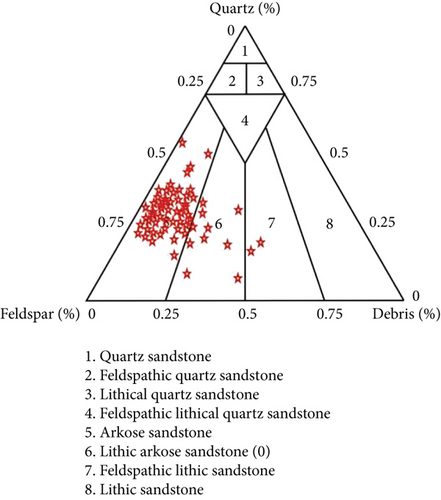
4.2. Physical Characteristics
The statistics of reservoir physical property show that the porosity of reservoirs in the Chang 6 Formation is 0.58% ~20.28%, with an average of 10.1%, and the main distribution range is 6.0% ~14.0%. The permeability is (0.003 ~ 3.22) × 10−3 m2, the average is 0.28 × 10−3 μm2, and the main distribution range is (0.1 ~ 0.5) × 10−3 μm2. It has the low porosity and low permeability characteristics.
In these thick massive sandstones, the sandstone cemented by chlorite clay film has relatively good physical properties generally and is made into the main target area of oil and gas exploration.
4.3. Characteristics of Sedimentary Facies
Chang 63 Member is the main exploration target in the Huaqing region; so, the sedimentary facies types and characteristics were studied in depth aiming at Chang 63 reservoirs. Based on the study of sedimentary facies markers, it is concluded that the sedimentary facies of the Chang63 Member belong to the turbidite fan sedimentary system formed by the rapid accumulation of sandy sediments in the delta front and have the turbidite facies markers such as grain sequence stratification, liquefaction encapsulation stratification, sliding cutting and deformation structure, groove mode, groove mode, and heavy load mode.
In the area of inner fan and middle fan, the thickness of sandstone is relatively large, sometimes more than 10 m, and it is a little gradient on the top, showing a blocky shape. The mudstone interlayer is extremely thin or missing, with a certain rhythmic feature, and there is a micro scour phenomenon in the process. But on the whole, it is mainly blocky sandstone, and the GR logging curve is mainly box-shaped (Figure 4). In the outer fan region, it is shown in the section as the sandstone with progressive stratification of fixture in deep water mudstone. The thickness of single layer is generally less than 0.5 m, the sedimentary structure is rich, and the Bouma sequences can be seen. There are trough mode, heavy load mode, and flame structure at the bottom (Figure 5).
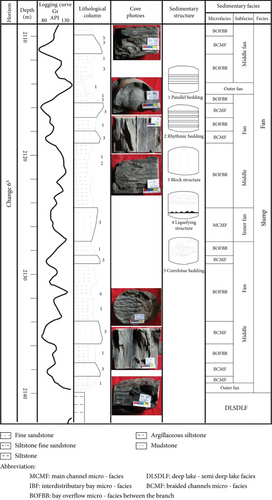
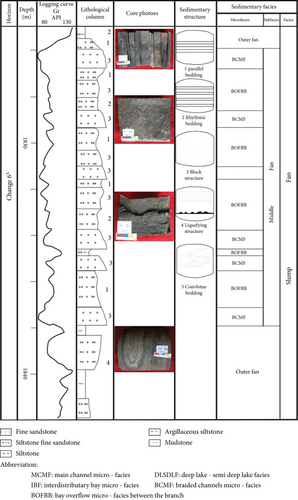
It can be known from the sedimentary facies plan of the Chang63 Member (Figure 6) that there are five turbidite fans in the bottom of the lake, and the left three ones are small in the southeast of the lake. These turbidite fan bodies can be regarded as the products of strong slip and near-base turbidity caused by the progradation instability of delta front sedimentary bodies in the direction of southern lake center. Affected by the topography of high north and low south, the facies belt appears from north to south: inner fan⟶middle fan⟶outer fan⟶half deep lake⟶deep lake facies.
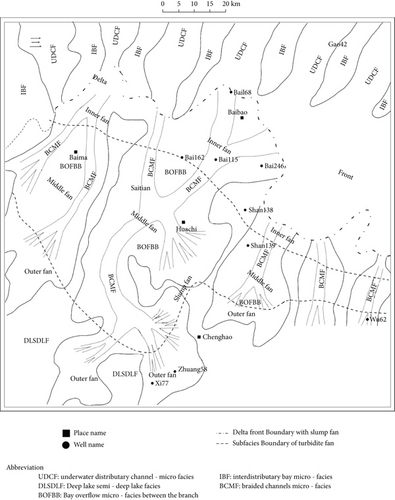
4.4. Characteristics of Chlorite Clay Films
- (1)
The chlorite clay film on the surface of the particles in the pore is nearly equal thickness (Figure 7(a))
- (2)
The chlorite clay film is usually a double layer structure, the inner ring boundary cementation is dense, the outer green clay crystal shape is good, and it presents leaves or needle and is vertical to the ring boundary layer to the pore growth (Figures 7(a) and 7(b))
- (3)
The chlorite cementation is less at particle contact (Figure 7(c))
- (4)
The granule contact relation of the sand body developed by the chlorite clay film is mainly point contact and line contact (Figures 7(d) and 7(f))
- (5)
There exist spontaneous quartz crystallites where chlorite clay membranes develop (Figure 7(g))
- (6)
Feldspars or cuttings particles wrapped in the chlorite clay film will form the pores similar to the formation of mold holes after corrosion (Figure 7(h))
- (7)
The chlorite clay film cementation coexists with laumonite cementation (Figure 7(e)) or carbonate cementation (Figure 7(d) and 7(f))
- (8)
Chlorite could grow around spontaneous quartz and gradually encase it

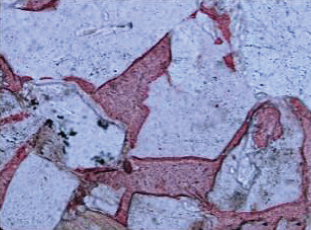
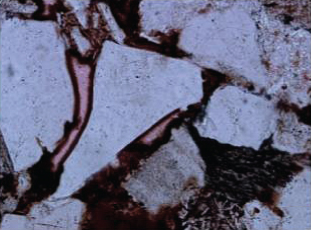
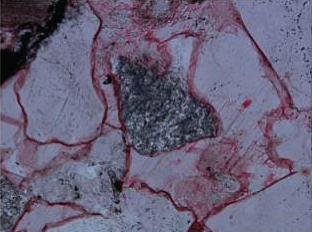
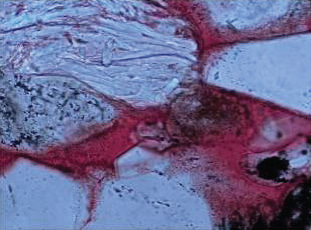
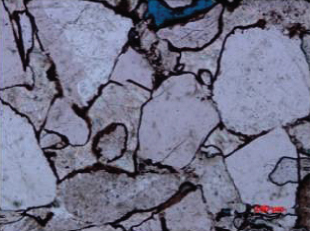

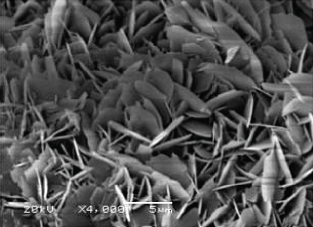
Through the above studies, it is concluded that chlorite minerals exist in sandstone reservoirs in three ways:
The first condition is in the form of heterozygote dispersed in the intergranular pores, and its self-form degree is better, showing a rose shape. The second shape is in the form of pore lining. The chlorite crystal is like a bamboo leaf, growing perpendicular to the surface of the particle towards the pore center. The closer it is to the pore center, the better its self-shape will be. The third one is in the form of the pellet envelope. Its thickness is small, and it is mainly distributed on the surface of particles. At the point of pore contact, it is perpendicular or oblique to the particle surface, while at the point of particle contact, it is parallel to the particle surface (Billault et al., 2003) [3].
4.5. Diagenetic Sequence
- (1)
Under the optical microscope, chlorite films are missing at the contact point of some clastic particles, while part of the chlorite film in the body cavity of the pore is thicker. According to this kind of phenomenon, Huwang et al. [5] considered that chlorite clay films were formed relatively late. However, Billault et al. [3] also observed chlorite crystals at the contact point of the clastic particles through the transmission electron microscope, indicating that the formation of chlorite clay film was early and may have started in the codeposition period. The autologous chlorite crystal in the pore and the autologous chlorite crystal in the surface of the clay film indicate that the formation of chlorite continued until the middle and late diagenesis
- (2)
The intergranular pores were filled with a large number of medium-term calcite cementation, and chlorite thin films could be seen on the surface of surrounding clastic particles, suggesting that the development time of chlorite thin films was earlier than that of medium-term calcite cementation
- (3)
The turbidity zeolite cement can be seen in the pores, and surrounding particles are wrapped by chlorite films, indicating that the turbidity zeolite cementation is later than the chlorite film
- (4)
The dissolution pores of feldspar and cuttings are filled with late calcite, indicating that the late calcite consolidation is later than the dissolution of feldspar and cuttings, and the residual asphalt can be seen in the dissolution pores, suggesting that the dissolution occurred at the same time or a little later than the oil and gas filling
Based on the above analysis, it is concluded the main diagenetic evolution sequence of reservoirs in Huaqing region of Ordos Basin: early chlorite consolidation⟶compaction⟶early calcite cementation and aumonite cementation cementation⟶organic acid entry⟶dissolution of feldspar and rock debris⟶solution of turbid zeolite and calcite⟶secondary quartz⟶late ferric calcite cementation (Figure 8).
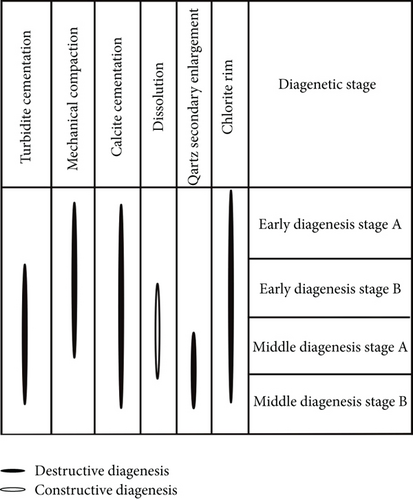
The occurrence of diagenetic events is a long-term process; so, a variety of diagenesis will take place at the same time in a certain period of time. The superposition will occur in the combination of time and space, and the destruction and construction of the reservoir may take place at the same time.
5. Discussion
5.1. The Material Source of Chlorite Clay Film
- (1)
Hydrolysis of minerals with rich iron and magnesium will release large amounts of iron and magnesium ions, such as biotite, amphibole, and iron-rich tuf [27]
- (2)
Dissolution of soluble iron-bearing minerals will produce a large number of iron and magnesium ions, such as the feldspar
- (3)
Sruoga et al. believed that the water displays weak alkalinity and weak reduction due to the change of water salinity at the junction of rivers and oceans. Iron ions dissolved in the river water would flocculate and precipitate under such conditions, which would provide abundant iron sources for the formation of chlorite rim cement [28]
When Zheng Rongcai (2008) studied the salinity of the ancient water medium in the lake basin of the Chang 6 period in Huaqing region, and they believed that the water body of the lake basin of the Chang 6 period was brackish to semibrackish. When the rivers in the north and northeast of the working area enter the lake, the salinity of the water body changes greatly, and the dissolved iron ions in the river water will produce a large amount of flocculation precipitation. In the syndepositional period, a layer of iron-rich particle coating would be deposited on the surface of the particles, which is one of the main material sources of chlorite clay film.
The content of feldspar and debris is higher in the Chang 6 reservoir sandstone in Huaqing region, which is mainly influenced by the paleo-Yinshan metamorphic rock in the north and the Lvliangshan granite in the northeast margin. A lot of acid fluid will be produced in the process of source rock maturation. In the process of dissolution of feldspar, biotite, and volcanic debris in the reservoir, a large amount of iron ions will be produced, which is also a main material source of authigenic chlorite.
5.2. Relationship between Chlorite Clay Film and Sedimentary Facies
Baker et al. (2000) [21] pointed out that the spontaneous chlorite produced in the pore lining is a good indicator of the sedimentary environment of deltas (such as distributary channels) under the influence of seawater. Jinku et al. (2009) found that the development of chlorite rim cement was significantly controlled by sedimentary environment, and it was mainly developed in the subaqueous distributary channel and estuary dam area of delta front when the sandstone reservoirs from Xujiahe Formation of Baojiajie region in Central Sichuan and South Sichuan were studied [22]. Similar research results have also been reported in the Jurassic braided river delta reservoir of the Cainan in Xinjiang and the delta sand body of the Triassic Xujiahe Formation in western Sichuan [29].
In this study, it is also found that there is a coupling relationship between the sedimentary facies and chlorite clay film.
After comprehensive analysis, the Chang 6 Formation in the Huaqing region is determined to belong to lake bed slump turbidite fan sedimentary system that is formed because of delta front rapid accumulation of sediments. Its genesis is related to the rapidly increasing slope topography in the delta front advancing southward from the north. When the Angle of sediment accumulation exceeds stability of repose angle, or instability in sedimentary bodies under the action of external force, a large number of sediment under the action of gravity is liquefied, mobiled, and downed along the slope of the sliding, eventually moved to prodelta or more deep water lake in the form of high density turbidity current, and extensively formed the slump turbidite fan sedimentary system in the bottom of the lake.
The turbidite fan sandstones are all developed in the three reservoir members of the Chang 6 Formation, and the Chang 63 Member is the most developed. It can be further divided into three subphases of inner fan, middle fan, and outer fan.
According to the statistical analysis of the content, porosity, and sedimentary facies of autologous chlorite, the sandstones in the inner fan area are coarser in size and are dominated by medium-fine sand, with autologous chlorite content of 2-3% and porosity of 10-15% (Figure 9). The sandstones in the middle fan area are mainly fine sandstones and silty sandstones, with chlorite content of 1-2% and porosity of 5-10% (Figure 9). The outer fan sandstones are generally silt and argillaceous silt with dense lithology and its chlorite content is less than 1% (Figure 9).
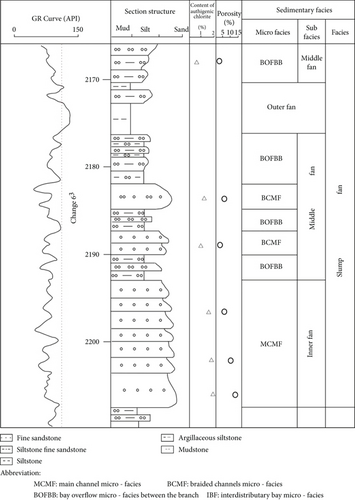
According to the analysis, the sedimentary microfacies of the sand body with the most developed chlorite clay film are basically the microfacies of the main channel of the inner fan and the branch channel of the middle fan of the turbidite fan.
Since the channel and branch channel are the strongest hydrodynamic conditions of turbidite fan area, very fine clay particles cannot be precipitated in this environment but can be adsorbed at grain surface, slowly to form a thin layer of thickness-equal ring boundary layer. Its formation mechanism is similar to the formation of particles in the olitic limestone of the carbonate platform edge. In the strong hydrodynamic stirring environment, terrigenous clastic particles or fossils particles surface can absorb the subtle colloidal substances, bond clay, or carbonate particles and gradually form the boundary layer thickness ring. This equal-thickness circumferential layer is the basis for the formation of chlorite clay film, which mainly forms the inner layer of the clay film. If the hydrodynamic force is weaker, the clay particles will directly precipitate to form the clay matrix and fill the pores between the particles.
It can be seen that strong hydrodynamic force should be a necessary condition for the formation of chlorite clay film, and it can be determined that the chlorite clay film is one of the microfacies markers of strong hydrodynamic conditions.
5.3. Formation of Chlorite Clay Films
According to various diagenetic phenomena about chlorite clay film, the formation of chlorite clay film is considered as a gradual process, the chlorite film is mainly formed in the early stage, and the chlorite lining is formed in the later stage.
It can be mainly divided into three stages (Figure 10):
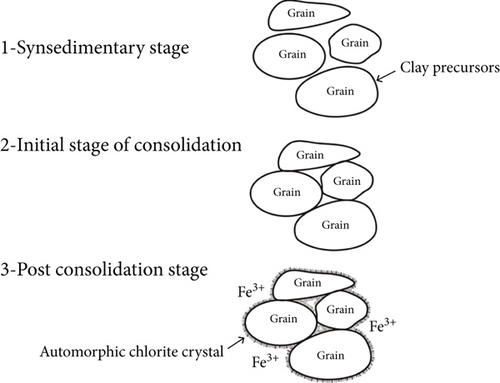
5.3.1. Syndepositional Stage
In the delta front area, the water medium changes greatly as the river enters the brackish water lakes, and the clay minerals carried by the river flocculate to form iron-bearing sediments. These sediments adsorb on the surface of clastic particles and form clay precursors of chlorite clay film.
5.3.2. Initial Stage of Consolidation
As the burial deepens, the particles come into close contact. At the contact point of the particles, the clay film will become thinner due to the action of pressure.
5.3.3. Postconsolidation Stage
Iron and magnesium ions produced by dissolution of clastic particles, such as feldspar, volcanic debris, and biotite, provide abundant material sources for the formation of chlorite. These iron-rich fluids, on the one hand, make the clay precursor gradually chloritized, and on the other hand, chlorite crystals are precipitated in the intergranular pores. Part of the clay film perpendicular to the surface of the particles is like a needle leaf, while part of it is distributed in the intergranular pores, like a ball wool.
5.4. Study on the Protective Mechanism of Chlorite Clay Film to Porosity
The relationship between chlorite clay film and physical properties has always been controversial, but most scholars believe that chlorite clay can protect the pores of sandstone, but this study believes that the ability of chlorite clay film to protect the pores of sandstone is limited, and the sandstone with better physical properties is mainly controlled by its own petrological characteristics.
5.4.1. The Chlorite Clay Film Has Limited Protection for Sandstone Pores
(1) The Chlorite Clay Film Could Not Inhibit Quartz Secondary Enlargement. The silica cement in the sandstone body that developed chlorite clay film is generally not developed. There are many reports that chlorite clay film inhibits quartz secondary enlargement, and many different views exist.
Ehrenberg [2], Yiqun et al. [6], and Huang et al. [5] believe that authigenic chlorite spatially separates the crystal base (particle surface) of authigenic quartz from pore fluid, thus inhibiting authigenic quartz from nucleating on these quartz particles and inhibiting secondary quartz cementation. Billault et al. [3] observed under the transmission electron microscope that there were a large number of intercrystalline pores between the crystals of chlorite in the pore liner; so, it could not really separate the pore fluid from the particle surface. Many tiny spontaneous quartz crystals are formed in the porous space between quartz particles and the overlying chlorite crystal.
Therefore, Billiault et al. believe that the chlorite clay film developing sand body does not lack spontaneous quartz nucleus, but the development of chlorite crystal leads to the serious limitation of the growth space of spontaneous quartz nucleus, which leads to the undeveloped spontaneous quartz cementation. The author believes that the development of chlorite clay film is a progressive process: before the chlorite crystal precipitates out, the early clay precursor isolates the particles from pore fluid and prevents the nucleation of quartz particles, thus inhibiting the increase of secondary quartz. In the later stage, under the action of the iron-rich fluid in the pores, the clay precursor was gradually turned into chlorite, and a large number of autologous chlorite crystals were precipitated from these films to form the pore lining, and a large number of quartz microcrystals were developed in the intercrystalline pores between the chlorite crystals. However, the diagenetic environment at this time is alkaline, which is not conducive to the precipitation of siliceous substances, but the fundamental reason for the absence of further cementation of these quartz microcrystals. In some sandstone reservoirs, the clastic particles are wrapped by chlorite clay film, and the intergranular pores are filled with calcite cement or turbidity zeolite cement, indicating that chlorite clay film cannot prevent intergranular pores from being cemented.
(2) The Chlorite Clay Film Cannot Increase the Compressive Strength of Granule nor Can It Protect the Pore. Clay minerals are not prone to corrosion, but the feldspar and volcanic debris are prone to corrosion with acidic fluids. If the particles with the chlorite clay film are feldspar and volcanic debris, a chlorite clay film cladding will be left after full dissolution, and the corrosion holes are similar to the mould hole. According to Huang et al. (2004), this kind of mold hole does not collapse, indicating that chlorite clay film has certain supporting effect and can improve the mechanical strength of rock and the ability to resist the compaction.
The author believes that the failure of the mold hole of the clay film is due to the surrounding skeleton particles bearing the overburden pressure, which cannot be taken as an evidence that the chlorite clay film can improve the mechanical strength and resistance to the compaction of the rock. In some sandstone reservoirs of other oilfields, feldspar particles without the protection of chlorite clay film do not collapse after dissolution. The chlorite is a clay mineral with Mohs hardness of 2 ~ 3 at normal temperature, while the quartz has Mohs hardness of 6 ~ 7 and the feldspar has hardness of 6 ~ 7. Clay films are plastic relative to quartz and feldspar grains at underground high temperatures and pressures; so, their supporting capacity is limited.
In the Yanchang Group of the study area, the compaction of sandstone is strong, and the compaction deformation of plastic volcanic debris and argillaceous debris, or even pseudoparasification, is very common. Therefore, the emergence of chlorite clay film can significantly improve the mechanical strength and compaction ability of rocks, which lacks the basis of petrology and mineralogy.
(3) The Authigenic Chlorite Has the Intercrystalline Porosity but Has a Limited Effect on Porosity. Hurst and Nadeau (1995) [30] studied the intercrystalline porosity of authigenic clay minerals using BES (backscatter electron microscope). The mean intercrystalline porosity of authigenic chlorite was 51%, and some of these intercrystalline pores might be effective storage space. Authigenic chlorite itself will occupy part of intergranular pores, resulting in porosity reduction. As can be seen from the mold diagram of chlorite clay film formation, the volume of intercrystalline pore formed by the chlorite clay film is negligible compared with that of intergranular pore. Therefore, the intercrystalline pore of the spontaneous chlorite cannot increase the effective porosity, never protecting the intergranular pore.
(4) The Chlorite Clay Film Can Reduce the Reservoir Permeability. In order to study the relationship between the chlorite clay film content and permeability, the author analyzed the influence of chlorite clay film on permeability by studying the relationship between chlorite clay film content and permeability of sandstone reservoirs with the basically same porosity.
It can be seen from the Figure 11 that the higher the content of authigenic chlorite is, the lower the permeability is, indicating that chlorite has the effect to reduce the permeability, and its content is negatively correlated with the permeability.
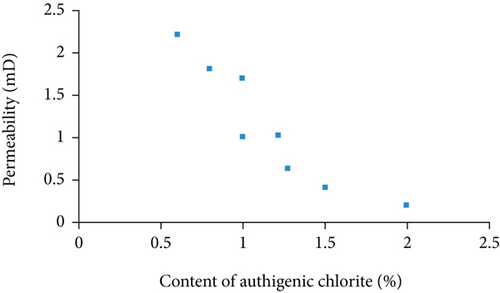
Although the sandstone reservoir with chlorite cement is more porous than the sandstone reservoir without chlorite cement in this area, it is true that authigenic chlorite occupies the intergranular pores and blocks the throat, thus reducing the permeability of the reservoir.
Through the above analysis, the chlorite clay film cannot stop the diagenesis, cannot improve the mechanical strength of the rock and the ability to resist the compaction, and more cannot increase the porosity of reservoir; so, the theory that the chlorite clay film can protect the notion of sandstone pore also is impossible. On the contrary, the chlorite clay film can shrink pores, plug the throat, and make the porosity and permeability reduced.
Due to the relatively thin and low content of chlorite clay film, its influence on porosity is also limited.
5.4.2. The Physical Properties of Sand Bodies with the Chlorite Clay Film Are Mainly Controlled by Petrological Characteristics
Although the chlorite clay film can reduce porosity and permeability, the sand body developing chlorite clay film has good physical conditions, and this phenomenon is indeed universal. The author believes that this is mainly determined by the petrological characteristics of sand body with chlorite clay film. From the formation process of chlorite clay film, it can be seen that the development of the clay film of reservoir sand body in the working area is obviously controlled by the sedimentary environment, which is mainly developed in the main channel of the inner fan and the branch channel of the middle fan of the sublacustrine slump turbidite fan.
- (a)
The sandstone has the coarse grain size and the higher initial porosity. The remaining porosity is also higher after the same compaction process. Better separation, better grinding circle, and large intergranular support area make the compaction resistance enhanced
- (b)
The matrix content is lower. Due to the strong hydrodynamic force, the deposition of fine silt and clay matrix is less, the unloading is basically coarse particles, the content of complex matrix is low, the sandstone is relatively pure, and the original intergranular pores are high
- (c)
The compaction has little effect, and there are many pores left, which can provide a migration channel for the flow of acidic water medium in the later stage, and are conducive to the continuous dissolution and transport of dissolved materials in the later stage, thus improving the connectivity of sandstone pore system
So, the physical properties of the sand body developed by chlorite clay film are better, which is mainly determined by the petrological characteristics of the sand body deposited under strong hydrodynamic conditions, and have little relation with chlorite clay film. Therefore, the attention should be paid to the sand body formed under strong hydrodynamic conditions in the exploration deployment of finding high-quality reservoirs in the Chang 6 Formation of the Yanchang Group in Huaqing region.
6. Conclusion
- (1)
The sedimentary facies of the Chang 6 Formation is mainly the sublacustrine slump turbidite fan, and the chlorite clay film cementation mainly occurs in the main channel microfacies of the inner fan and the distributary channel microfacies of the middle fan, which is one of the microscopic signs of strong hydrodynamic conditions
- (2)
The formation model of chlorite clay film is proposed. It is a gradual process: the particle envelope is mainly formed in the early stage, and the chlorite lining is mainly formed in the late stage. And it can be divided into three stages: the synsedimentary stage, the initial stage of consolidation, and the postconsolidation stage
- (3)
Chlorite clay film cannot prevent diagenesis, improve the mechanical strength, and compressive strength of rock, nor can it increase the porosity of reservoir. The physical properties of the sand body developed by chlorite clay film are better, which is mainly determined by the petrological characteristics of the sand body deposited under strong hydrodynamic conditions, and have little relationship with the chlorite clay film
Conflicts of Interest
The authors declare that they have no conflicts of interest.
Acknowledgments
The authors would like to acknowledge the financial support from the Scientific Research Funds of Education Department of Liaoning Province (General Project), China (LJKZ0330). The authors thank the guidance of Wang Qi professor of Lanzhou Geological Institute, Chinese Academy of Sciences, and the help of Liu Yue on the translation. The authors are also grateful to Chu Meijuan of the Changqing Oil Field for their assistance in the data support.
Open Research
Data Availability
The unit of permeability should be md. The other unit and statement are used constantly in the oil field.




